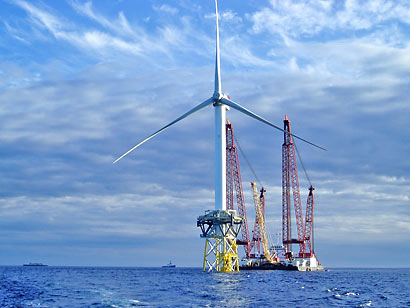The American Wind Energy Association lists a number of advantages to offshore wind, including harder wind, steadier winds, and because bigger turbines can be placed. In densely populated Europe, with its large shallow offshore sites, it looks even more attractive. This is less the case in the US, where strong winds blow in land areas that are not densely populated, and shallow seas away from shipping lanes are not as available.
The EU goal is 4% of its electricity from sea-based wind by 2020, but there are problems. The increase in materials cost, a shortage of ships to service the windmills (vessels and workers were thought to become available as North Sea oil and gas fields became depleted, but instead moved to other parts of the world), shortages of cables to connect windmills to the grid, and general concerns about cost and reliability. From Bloomberg:
“It’s been more difficult to build offshore projects than everyone thought,” said Goeran Lundgren, head of Nordic power generation at Stockholm-based Vattenfall AB, which has put a 640- megawatt wind farm in the Baltic Sea on hold. “I don’t think we’ll see any large-scale offshore parks until we’ve taken a few big development steps.”

5 MW wind turbinein the North Sea
Rotor blade diameter is 126 m (415 feet). The blades rotate for wind speeds between 7 and 70 mph, with maximum power produced at 30 mph. The expectation was that they would run 96% of the time, and at maximum power 38% of the time.
Discouraged companies include Shell and the German E.ON, Germany’s biggest utility and experienced in wind power. The two major suppliers of offshore wind, Vestas from Denmark and General Electric from the US, are focusing on more profitable onshore wind.

The actual cost of off shore wind projects is hard to come by, and for good reason. The cost are truly staggering. One off shore project, located off Long Island was priced at $811 million for 140 MW of generating capacity. I believe that the capacity factor was 38%. Once the Long Island power company found out the price, they backed off of the project real fast.
Having spent at least a few days of my life on an offshore sailboat waiting for the wind to blow, I have a difficult time believing the projected wind regimes for “offshore” projects. Of course, there is the possibility that the winds at the height of the turbine towers are much different from those at ground level, but even that assumption strains my understanding of how wind works.
There are good reasons why highly refined and sophisticated sailing ships lost in the economic competition against even primitive coal burning ships in an era where coaling stations had to be developed.
Sailing ships required a large crew of people to work very hard to keep the ship moving in an environment of ever changing wind.
They required massive expanses of wind catching material that was costly to produce and expensive to maintain.
They could only move a small amount of compact cargo and it was best if that cargo had a long shelf life – masters with decades of experience on the open ocean could not predict the length of their voyage with anything close to accuracy.
There were only certain routes – often following the trade winds that are a result of the earth’s rotation – that made any sense at all.
I would bet that there are few observant off shore sailors invested in off shore wind developments.
On another note – I have also spent many years in jobs associated with maintaining complex machinery and fixed structures in an ocean environment. I cannot imagine a good cost/benefit ratio for the kinds of systems required for offshore wind turbines. Owners are going to have a very difficult time finding a skilled crew willing to work on a 5 MW generator and gear based drive train at the top of a 300 foot tall crane. If they can find crews, they are going to be surprised by the day rates required.